FEATURED LETTER
Letter from Alfred Gerald Crofton to Lady Clonbrock, 1 October 1916 (National Library of Ireland)
by Dr Brian Hughes
Over 210,000 Irish men, all volunteers, served in the British armed forces during the Great War. For a long time overlooked, or even forgotten, the contribution of these men has finally achieved due recognition and will continue to do so as the centenaries of the events of the Great War are marked. Less well remembered are the undetermined numbers of natives of Ireland who enlisted in units in Britain, the colonies or the US and are not represented in that figure of c. 210,000. This is, perhaps, surprising given Ireland’s long history of outward migration and our modern interest in the Irish diaspora but is also reflected in the relative absence of attention paid to the Irish born who fought in the American Civil War. The story told by a letter written by Alfred Gerald ‘Fred’ Crofton (1882-1964) to his aunt, Augusta Caroline Dillon, Lady Clonbrock (1840-1928), is part of the story of the contribution of the Irish diaspora to the Great War and serves as a reminder of the varied and complex nature of Irish involvement in that war.
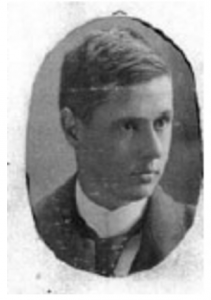
Born in Dublin on 18 June 1882, Alfred Crofton was not an obvious candidate for emigration. His paternal aunt and addressee of the letter was Augusta Caroline Dillon (née Crofton), Lady Clonbrock, or, as she was known to Alfred, ‘Aunt Tweety’. Lady Clonbrock was the wife of Luke Gerald Dillon (1834-1917), 3rd Baron Clonbrock of Ahascragh, County Galway. The exact reason is unclear, but in 1897, at the age of only 15, Crofton emigrated to Canada, then a dominion of the British Empire. The 1901 Canadian census finds the eighteen-year-old Crofton working as a farmer in Vancouver, British Columbia, and living in an eclectic household made up of a fellow Irish émigré, John Scovell, English-born Walter Rickets and a H Matsumoto from Japan. Two years later Crofton married Frances Nona Wilson, born in British Columbia to English parents, in Ganges on Saltspring Island, British Columbia.
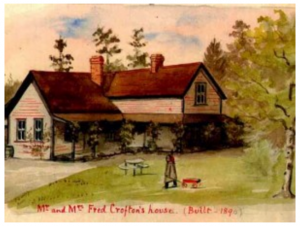
By 1911, Crofton was running a ranch on Saltspring Island and living there with his three children and two boarders. Alfred and Nona would go on to have seven children in total. It appears that at some stage the family left Canada for the United States as Nona Crofton and the three children are found on the 1910 US census – Alfred’s named is crossed off indicating that he may have been away from home on the night the census was taken. Within five years of his return to Canada, Alfred Crofton left again, this time alone.
On 10 December 1915, Crofton enlisted in the Canadian Expeditionary Force (CEF) and volunteered for over-seas service. As a dominion of the British Empire, the British declaration of war on Germany in August 1914 meant that Canada was also at war. The CEF was created specifically for over-seas service during the war and over 600,000 Canadian men and women served in the force as soldiers, nurses and chaplains. Like many volunteers, Crofton signed up for a unit with links to his own locality, the 88thBattalion (Victoria Fusiliers) recruited mainly from British Columbia. His attestation papers give us a physical description of the man who had just signed up for war: aged thirty-three years and six months, 5” 11’ in height, a 36’ chest, fresh complexion, brown hair and eyes and, more unusually, a tattoo on both arms.
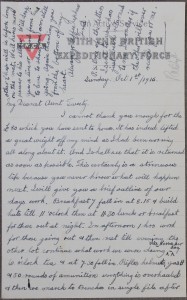
The 88th Battalion left Canada for England in spring 1916 and by the time Alfred wrote his letter to his Aunt Tweety in October 1916 they were on the Western Front, having been absorbed into the 30th Canadian Reserve Battalion. Written on British Expeditionary Force paper, provided by the YMCA whose volunteers aimed to provide comfort to soldiers at the front, the letter essentially describes a day in the life at war for Albert Crofton. Most of his work was manual – building huts, cleaning and overhauling equipment, marching and filling sandbags – but not without danger. Crofton and his colleagues were required to ‘hop the parapet’ and fill sand bags within a short distance of German trenches and under fire. The unpleasant aspects of trench life are featured: rats ‘as big as cats’, water, wet clothes and working where the dead have been buried. Not untypically, with censorship in place and a desire not to worry loved ones unduly, the description of trench life is largely stoical and, at times, even light-hearted. The men ‘plug along filling sacks’ while under fire, the ‘boys are very cheery and make jokes about Fritz’s shooting although sometimes he gets a bit too close to be pleasant’, ‘we are all merry and bright’ while officers ‘do their very best to make life as enjoyable as possible’. Tellingly, however, there are hints of the real trauma of the war:
‘it does not always do to show what you really feel. But believe me, their [sic] is not a man who does not wish it all over now but it must be seen through, now or never.
He also refers to ‘Edward’, possibly a relative or family friend also serving, who has been ‘shamefully treated’ and hopes that he will be reinstated.
So what brought Alfred Crofton to Western Front in October 1916? In many senses he was not the typical recruit. At thirty-three he was far older than the average recruit, he had been married over a decade and was the father of six children. He had not been caught up in any hysteria generated by the outbreak of war, signing up as he did well into the war’s second year. Economic necessity and the attraction of steady pay and a ‘separation allowance’ paid to dependents is often acknowledged as a powerful incentive behind recruitment but this is usually used to explain enlistment among the urban poor. Alfred Crofton was a rancher with aristocratic family connections – as his letter shows, Lady Clonbrock was able to send his wife the significant sum of £80. It is in an earlier letter to Lady Clonbrock that Crofton’s reasons for enlisting are explained. Writing on 13 December, three days after he had signed his attestation form, Crofton wrote:
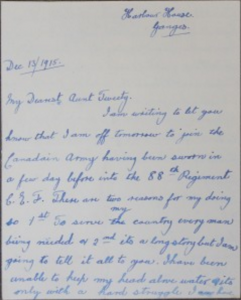
I am writing to let you know that I am off tomorrow to join the Canadain [sic] army having been sworn in a few days before into the 88th Regiment C.E.F. There are two reasons for my doing so. 1stTo serve my country [significantly, he crossed out ‘the’ here and replaced it with ‘my’] every man being needed & 2nd its [sic] a long story but I am going to tell it all to you.
That second reason is, perhaps, the most pertinent and also serves to explain why Lady Clonbrock sent £80. Crofton had been struggling to ‘keep my head above water’ and had accrued debts of $400, or £80, which he was unable to meet. Not wanting to worry his mother and fearing leaving the debt hanging over his wife while he was gone, Crofton hoped that Lady Clonbrock would cover it, promising (perhaps optimistically) that it would be ‘the 1st debt paid on my return from the war’. The letter also makes clear the financial rationale behind the decision to fight. With the debt covered and Nona’s brother helping with the farm, she would open a boarding house, which, it was hoped, would be in profit after the first year. Also, ‘With ½ my pay & her separation allowance for a wife and six children Nona will … have something for her to live on.’
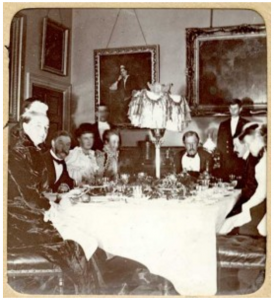
Alfred Crofton (and his family) survived the war and returned to Ganges. On the 1921 census his occupation had been downgraded to ‘Farmer’ but there were six lodgers living in the house. A seventh child, Dulcie, had been born about two years after the war. He died, aged sixty, on 3 October 1942.
One can only assume that he repaid the £80.
Dr Brian Hughes is the author of Michael Mallin (O’Brien Press) which was published in 2012 as part of their 16 Lives series of biographies. He was recently awarded a PhD at Trinity College Dublin. His dissertation entitled Defying the IRA: intimidation, coercion and communities in Ireland, 1917-1922, was completed under the supervision of Dr Anne Dolan.
Sources
1901 Census of Canada (www.ancestry.com)
1910 United States Federal Census (www.ancestry.com)
1911 Census of Canada (www.ancestry.com)
1921 Census of Canada (www.ancestry.com)
Attestation Paper, Canadian Over-Seas Expeditionary Force, Alfred Gerald Crofton (http://www.bac-lac.gc.ca/eng/discover/military-heritage/first-world-war/first-world-war-1914-1918-cef/Pages/item.aspx?IdNumber=126029)
British Columbia, Canada, Death Index, 1872-1990 (www.ancestry.com)
British Columbia, Canada, Marriage Index, 1872-1935 (www.ancestry.com)
National Library of Ireland, Clonbrock Estate Papers, Collection List No. 54.
Salt Spring Island Archives (www.saltspringarchives.com)